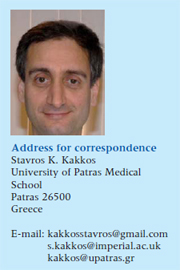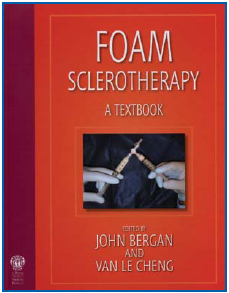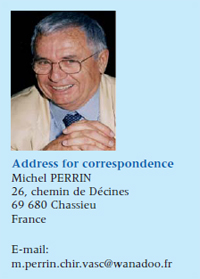About new articles and books
Based on an original review: Kakkos SK, Caprini JA, Geroulakos G, Nicolaides AN, Stansby GP, Reddy DJ. Combined intermittent pneumatic leg compression and pharmacological prophylaxis for prevention of venous thromboembolism in high-risk patients. Cochrane Database Syst Rev. 2008, Issue 4. Art. No.: CD005258. DOI:10.1002/14651858.CD005258. pub2
Joseph A. CAPRINI2
George GEROULAKOS3
Andrew N. NICOLAIDES4
Gerard P. STANSBY5
Daniel J. REDDY1
Department of Surgery, Detroit, USA
2 Department of Surgery, Evanston
Northwestern Healthcare, Evanston, USA
3 Vascular Unit and Department of Vascular
Surgery, Ealing Hospital and Imperial College,
London, Southall, UK
4 Vascular Screening and Diagnostic Centre,
and Cyprus University, Nicosia, Cyprus
5 Department of Surgery, University of
Newcastle upon Tyne, Newcastle upon Tyne, UK
A review by Stavros K. KAKKOS
Update Cochrane review on the prevention of venous thromboembolism.
SUMMARY
Introduction
Despite the use of contemporary prophylactic measures, the incidence of venous thromboembolism (VTE, defined as deep vein thrombosis [DVT] or pulmonary embolism [PE] or both) is still great especially in high-risk patients, including those undergoing total hip or knee replacement, or colorectal surgery for cancer. In an effort to intensify thromboprophylaxis, the consensus guidelines on this topic have recommended combined pharmacological and mechanical prophylaxis in high-risk patient groups. This suggestion is based on evidence that combined modalities (intermittent pneumatic leg compression and pharmacological prophylaxis) are more effective than single modalities (intermittent pneumatic leg compression or pharmacological prophylaxis) in preventing VTE in such patients. The enhanced efficacy of combined modalities is possibly the effect of intensified intervention on more than one element of Virchow’s triad.1 The aim of the present study was to review the efficacy of intermittent pneumatic leg compression combined with pharmacological prophylaxis compared with single modalities alone in preventing VTE in high-risk patients.
METHODS
Randomized controlled trials and controlled clinical trials of combined intermittent pneumatic leg compression and pharmacological interventions, used to prevent VTE in high-risk patients, were identified from the following databases: Cochrane Central Register of Controlled Trials database, the Specialized Register of the Peripheral Vascular Diseases Group (which contains citations of trials identified through electronic searches of MEDLINE and EMBASE), MEDLINE (through direct search). Hand searching of journals and conference proceedings was also performed. Data extraction was undertaken independently by two review authors (SKK & GG) using data extraction sheets.
RESULTS
Eleven trials including a total of 7431 patients were identified.2-12 Six of them were randomized controlled trials4,6,7,9,10,12 that involved a total of 6273 patients.
1. Compression + anticoagulant versus compression
Six of the included studies evaluated the role of combined modalities on the incidence of symptomatic PE.2-7 Compared with compression alone, the use of combined modalities significantly reduced the incidence of PE (from about 3% to 1%; odds ratio [OR], 0.39; 95% confidence interval [CI], 0.25 to 0.63). Results did not demonstrate heterogeneity or publication bias (I2= 0%). Four studies investigated the role of combined modalities on the incidence of DVT.2,5-7 Compared with compression alone, the use of combined modalities significantly reduced the incidence of DVT (from about 4% to 1%; OR 0.43, 95% CI 0.24 to 0.76). Results did not demonstrate heterogeneity or publication bias (I2= 0%).
2. Compression + anticoagulant versus anticoagulant
Four studies investigated the impact of combined modalities on the incidence of DVT.2,8-10 Compared with pharmacological prophylaxis alone, combined modalities significantly reduced the incidence of DVT (from 4.21% to 0.65%; OR, 0.16; 95% CI, 0.07 to 0.34). Results were consistent and demonstrated moderate heterogeneity (I2= 33%). Three studies evaluated the impact of combined modalities on the incidence of symptomatic PE.2,8,10 The incidence of PE was 0% in both the control group (0/214) and the treatment group (0/176), which indicates that the included studies were underpowered with regard to PE.
The comparison of compression plus pharmacological prophylaxis versus compression plus aspirin showed a nonsignificant reduction in PE and DVT in favor of the former group.11,12
Repeat analysis restricted to the randomized controlled trials confirmed the above findings.
CONCLUSIONS
The results of the present meta-analysis show that, compared with compression alone, combined prophylactic modalities significantly decrease the incidence of VTE. Compared with pharmacological prophylaxis alone, combined modalities significantly reduce the incidence of DVT, but the effect on PE is unknown because the relevant trials were underpowered. The results of the current review support the use of combined modalities in VTE prevention, especially in high-risk patients, provided that specific contraindications for each method are not present. More studies on the role of combined modalities in PE prevention, compared with pharmacological prophylaxis alone, are urgently needed.

REFERENCES
2. Bigg SW, Catalona WJ. Prophylactic mini-dose heparin in patients undergoing radical retropubic prostatectomy. A prospective trial. Urology. 1992;39:309-313.
3. Borow M, Goldson HJ. Prevention of postoperative deep venous thrombosis and pulmonary emboli with combined modalities. Am Surg. 1983;49:599-605.
4. Ramos R, Salem BI, De Pawlikowski MP, Coordes C, Eisenberg S, Leidenfrost R. The efficacy of pneumatic compression stockings in the prevention of pulmonary embolism after cardiac surgery. Chest. 1996;109:82-85.
5. Sieber PR, Rommel FM, Agusta VE, et al. Is heparin contraindicated in pelvic lymphadenectomy and radical prostatectomy? J Urol. 1997;158:869- 871.
6. Turpie AGG, Bauer KA, Caprini JA, Comp PC, Gent M, Muntz JE; APOLLO Investigators. Fondaparinux combined with intermittent pneumatic compression vs. intermittent pneumatic compression alone for prevention of venous thromboembolism after abdominal surgery: a randomized, double-blind comparison. J Thromb Haemos. 2007;5:1854-1861.
7. Woolson ST, Watt JM. Intermittent pneumatic compression to prevent proximal deep venous thrombosis during and after total hip replacement. A prospective, randomized study of compression alone, compression and aspirin, and compression and low-dose warfarin. J Bone Joint Surg Am. 1991;73:507-512.
8. Bradley JG, Krugener GH, Jager HJ. The effectiveness of intermittent plantar venous compression in prevention of deep venous thrombosis after total hip arthroplasty. J Arthroplasty. 1993;8:57- 61.
9. Eisele R, Kinzl L, Koelsch T. Rapidinflation intermittent pneumatic compression for prevention of deep venous thrombosis. J Bone Joint Surg Am. 2007;89:1050-1056.
10. Silbersack Y, Taute BM, Hein W, Podhaisky H. Prevention of deep-vein thrombosis after total hip and knee replacement. Low-molecular-weight heparin in combination with intermittent pneumatic compression. J Bone Joint Surg Br. 2004;86:809-812.
11. Westrich GH, Rana AJ, Terry MA, Taveras NA, Kapoor K, Helfet DL. Thromboembolic disease prophylaxis in patients with hip fracture: a multimodal approach. J Orthop Trauma. 2005;19:234-240.
12. Westrich GH, Bottner F, Windsor RE, Laskin RS, Haas SB, Sculco TP. VenaFlow plus Lovenox vs VenaFlow plus aspirin for thromboembolic disease prophylaxis in total knee arthroplasty. J Arthroplasty. 2006;21:139-143.
A review by Michel Perrin
Following the list of contributors, the two forewords and the preface of this hardcover book of 231 pages, the main text is divided into 3 parts: theory, practice, and special considerations, in 20 chapters.
It is noteworthy that two thirds of the authors—36 in total—are not from the USA, reflecting the fact that foam sclerotherapy was practiced earlier in Europe and Australia. Many authors are surgeons, which means that this foam sclerotherapy is no longer exclusively used by phlebologists. In other words, the practitioner who treats varicose veins has to master various techniques to give the patient the best possible treatment.
The first part of the book deals with the history and the guidelines for using sclerotherapy, and a fully illustrated chapter describes in detail the dermatologic manifestations of venous insufficiency. The second part is devoted to foam production and underlines the invaluable help provided by ultrasound investigation, including the postprocedure assessment. The third and last part mainly covers the indications for foam sclerotherapy in telangiectasias, large varicose veins, and recurrent varicose veins after treatment and vascular malformations (3 chapters). Besides the outcome of European randomized trials, a comparison of the efficacy of polidocanol versus sodium tetradecyl sulfate is reported. An original chapter underlines that the saphenous trunk, on which treatment was focused until now, can be spared in many cases, and that high ligation is no longer compulsory in
all patients.
In summary this book is an outstanding review of our knowledge of foam sclerotherapy, backed up by more than 600 references.

FOAM SCLEROTHERAPY.
A textbook. John Bergan, Van Le Cheng (editors),
Royal Society of Medicine 2008. ISBN 978-1-85315-771-4

